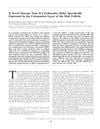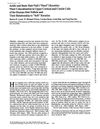TLDR Pangolin scales evolved for protection, hardening with age, due to keratin gene diversification.
The document discussed the evolution of integumental scale armor, focusing on pangolins, which have large, hardened scales made of α-keratins and β-keratins that provide high abrasive wear resistance. These scales, soft at birth and hardening with age, serve as armor when the animal curls up, offering defense with their sharp edges. The study highlighted the water-to-land transition in tetrapods, which led to a significant diversification of keratin genes, contributing to the development of rigid integumental structures and further keratin diversification in tetrapod lineages.
115 citations
,
November 2008 in “Proceedings of the National Academy of Sciences” Reptiles have genes similar to hair proteins, suggesting hair's genetic origins predate mammals.
1398 citations
,
May 2008 in “Histochemistry and Cell Biology” Keratins are crucial for cell stability, wound healing, and cancer diagnosis.
110 citations
,
August 2004 in “British Journal of Dermatology” The ventral matrix is the main source of the nail plate.
119 citations
,
January 2000 in “British Journal of Dermatology” Different parts of the nail express different keratins, showing unique patterns of differentiation.
 139 citations
,
December 1998 in “The journal of investigative dermatology/Journal of investigative dermatology”
139 citations
,
December 1998 in “The journal of investigative dermatology/Journal of investigative dermatology” K6hf is a unique protein found only in a specific layer of hair follicles.
 16 citations
,
August 1992 in “Archives of dermatological research”
16 citations
,
August 1992 in “Archives of dermatological research” Lab-grown nail cells show characteristics similar to natural nail and hair.
 356 citations
,
December 1986 in “The journal of cell biology/The Journal of cell biology”
356 citations
,
December 1986 in “The journal of cell biology/The Journal of cell biology” Hair and nail cells share similar proteins, indicating a common differentiation pathway.
19 citations
,
March 2013 in “Biology Letters” Early tetrapod keratins evolved into toe pad proteins in amphibians and hair proteins in mammals.


